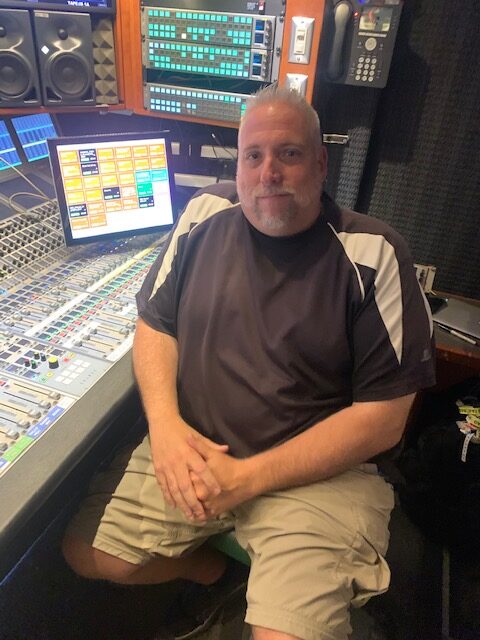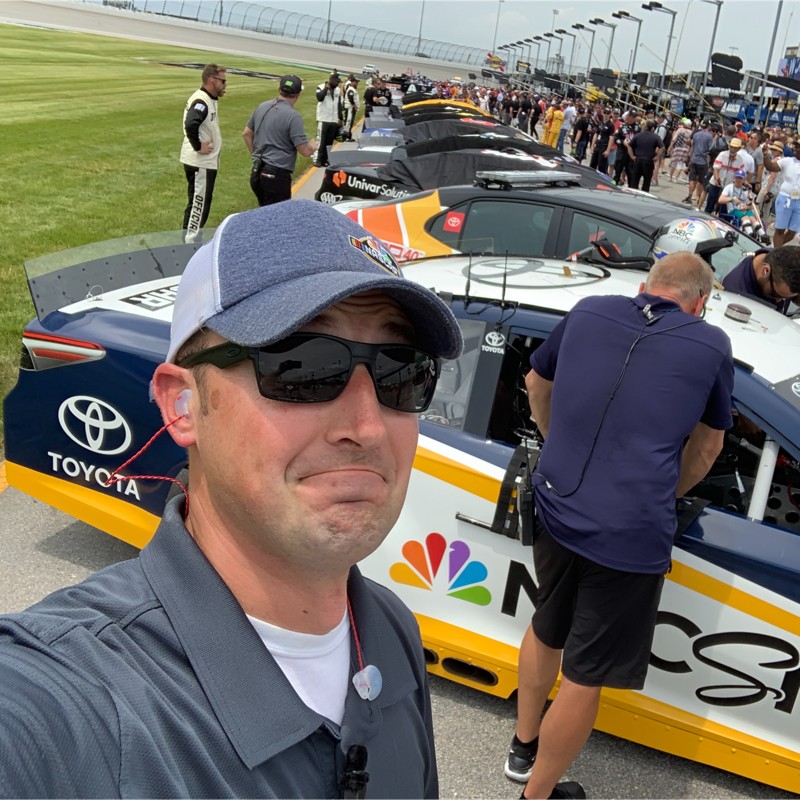Live From Nashville Superspeedway: NBC Sports Drops the Green Flag on Its Half of NASCAR Season
Smooth changeover characterizes the technical refinements NBC brings to the races
Story Highlights
NBC Sports kicks off its half of the 2023 NASCAR Cup and Xfinity Series with the Cup Series Ally 400 race Sunday, June 25 in primetime from Nashville Superspeedway. NBC’s Peacock streamer will exclusively stream a 30-minute post-race program immediately following the checkered flag at 11 p.m. ET. But getting the second half of the season under way did have one navigational hiccup.

“We had a couple of our guys accidentally go over to the fairground,” laughs NBC Sports Tech Manager Matt Hogencamp, referring to the vintage (and lately controversial) Nashville Fairgrounds Speedway, which is sometimes confused with the Superspeedway track about 30 miles east of the city in the suburb of Lebanon, TN.
At Nashville Superspeedway, NBC Sports set up its compound around Game Creek Video’s Peacock, comprising Peacock A (also home to the show’s broadcast-audio mix) and B and the Edit 1 truck (also used for the audio submix), as well as a truck for SMT’s graphics operations.

Game Creek Video’s Peacock A and B and the Edit 1 truck are at the heart of NBC Sports’ compound at Nashville Superspeedway.
According to Hogencamp, much of the race’s video infrastructure and workflow is similar to last year’s, which was the first NBC NASCAR race with a full complement onsite after two years of hybrid operations. This includes 10 dual-paths and 20 sources of in-car cameras, all deploying BSI’s recently developed in-car system: a new RF transmitter hub that, among other things, lets NBC add four audio channels per car, doubling previous years’ audio capacity. Hogencamp says the team is still figuring out how to best use the extra capacity. Fox Sports also had a crack at the new technology in the first half of the season.
“It gives us some options to grow and, hopefully, a new look at the sound for coverage of NASCAR,” he says. “There’s some stuff we’re testing that I can’t talk about yet because I don’t want to give too much away. But we’re still running down that path to see what we can do to add new sound to the coverage.”

SMT is in NBC Sports’ compound at Nashville Superspeedway to support graphics operations.
In addition, two SimplyLive ViBox replay systems for recording and playback are in place as an alternative replay system, primarily for in-car cameras to accommodate all that additional video capacity.
Graphics will also look familiar this season. NBC was able to integrate Chyron Prime for main graphics with new hardware that Hogencamp says is “cooking those machines along wicked fast.”
Peacock Pit Box Returns
Fans will see and hear the Peacock Pit Box again, expected to be part of 14 of NBC’s 20 races this season.
“The Peacock Pit Box is out in force this year,” Hogencamp says, “with the same setup that we’ve had in the past, with the Sony Robotics as well as a little mini jib on it. That’s our home base for our pre-race and post-race coverage: our signature that we love to have because it stands out — literally, one of the biggest things on Pit Road. You can’t miss it.”
NASCAR Audio Ahead of the Pack
Although the last year or two has seen a burst of activity around seeding athlete and player audio into the broadcast mix, Sam Flood, executive producer/president, production, NBC Sports, points out that NASCAR has been well ahead of the pack in that regard.

A1 Bryan Korot will handle both the NASCAR Cup Series Ally 400 in Nashville and the street-course race in Chicago.
“Different from the stick-and-ball sports, we’ve always had [that kind of] audio in NASCAR,” he says. “We’ve always had access to the drivers, to the crew chiefs. And we continue to lead into and take advantage of that access. When everyone is on a microphone, from the spotters to the crew chiefs, to each guy that goes over the wall so they can communicate because it’s so loud at the racetrack, we engage with all that audio.”
One of Flood’s favorite things to do on the telecast is to listen to the spotters as they take drivers and viewers around the track. He says fans can expect a couple of laps of that type of coverage. “It is a unique way to listen to a race: the spotter talks it through, and then to have [announcers] Dale [Ernhardt] Jr. and Jeff Burton translate the [jargon]. We feel that NASCAR is one of those great sports where audio’s always available, and we’re always leaning into it.”
Hogencamp will be working with an extensive onsite staff this year. It includes Bryan Korot and Steve Urick as A1 and submixer, respectively, of the event’s audio; Pete Girgenti as A1 relief; Mike Duke, managing RTS comms; Jeff Benhke, VP, NASCAR production and motorsports, NBC Sports Group; Senior Producer Renee Hatlelid; and Director Sean Owens (whom Hogencamp describes as “Rain Man — he just knows when stuff is going to happen”). Rick Allen will handle play by play, backed by analysts Earnhardt, Burton, and Steve Letarte. Pit reporters are Marty Snider, Dave Burns, Kim Coon, Kevin Lee, Parker Kligerman, and Dillon Welch. The studio-coverage team includes host Marty Snider and analysts Dale Jarrett, Kyle Petty, and Brad Daugherty.
Handing Off the Baton
Some might wonder whether picking up a major sports series from another television network midseason might be as competitive as collegial, but Hogencamp says that, in the end, each network is there to convey the sport’s narrative and build on the momentum, more like teammates in a relay race than sprinters on their own.
“We at NBC are committed to a level of production that, no matter what sport it is, we’re going to step up and do that,” he says. “We value NASCAR as a sport and want to showcase it for the amazing, almost gladiator-type event that it is: the man in the machine trying to battle it out.”
Korot points out that the level of interaction between NBC and Fox remains surprisingly high even after the handover. For instance, NBC technicians continue to support Fox Sports’ broadcasts of weekend events leading up to the marquee race, such as the Truck Series that opens the weekend on Friday with the 2023 Rackley Roofing 200, which will air on FS1 and stream live on Fox Sports Live and through the Fox Sports app.
“Basically, we supply [Fox] all our camera mics on the track, and they pick what they want,” he explains. “Our radio editor knows the radios onsite, and he’s feeding [the Fox plant in] Charlotte. There’s quite a bit of overlap [between the networks].”
Matthew Stovcsik, director, accounts, motorsports, BSI, which handles all RF operations for NBC Sports’ NASCAR shows, notes that the differences between Fox and NBC operations are minimal and revolve around house standards.
“The infrastructure here is all the same; it’s basically just a format change,” he explains. “We were delivering 1080p for Fox, and NBC is 1080i, so we do everything in 720p and then just cross-convert over for them. The cameras do get changed to 720. That’s really the only thing that changes. It’s a matter of getting into their workflow. This has been one of the smoothest changeovers. Everybody has their thing, and they know what to do. And here we are on Friday ready to make TV.”
Adds Hogencamp, “I view it as a partnership more than anything. Both networks have the same goal in mind: showcasing NASCAR. That helps both of us.”
Looking Ahead to Chicago: NASCAR Cup Series Street-Course Race
In some ways, the Nashville race is a warm-up for the upcoming, first-ever NASCAR Cup Series street-course race that will take place in Chicago on Sunday, July 2. Hogencamp says it will be “our high-water mark” of 80-plus NASCAR camera deployments, including 11 hard cameras, five RF cameras, six wired handhelds, eight super-slo-mo cams, and 25 robotic systems around the track. Korot describes the event as “our Daytona 500.”

NBC Sports’ Matt Hogencamp: “We want to showcase [NASCAR] for the amazing, almost gladiator-type event that it is.”
The Windy City races will also have two drones, from NBC Sports partner Beverly Hills Aerial, with one up in the air at all times. Each will be flying a Sony FX6 with associated lenses and transmitting via BSI. Hogencamp notes that the smaller of the two, the Hummingbird, can reach into spaces that the more powerful larger drones can’t get to because of their size and noise.
“We’re throwing the kitchen sink at Chicago,” he laughs. “That’s going to be our prime event for this year. The amount of planning that has gone into that and bringing everything together is enormous. I did my first site survey in October while we were still in our NASCAR season and have been living and breathing it ever since. We’re looking at it and planning for it the same way we do for the Indy 500. It’s going to be a spectacle, is how I would describe it. It’s going to be a showcase this year for NBC’s NASCAR coverage.”
